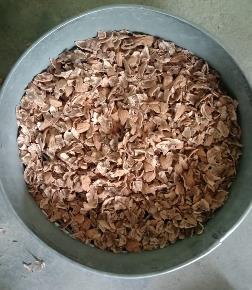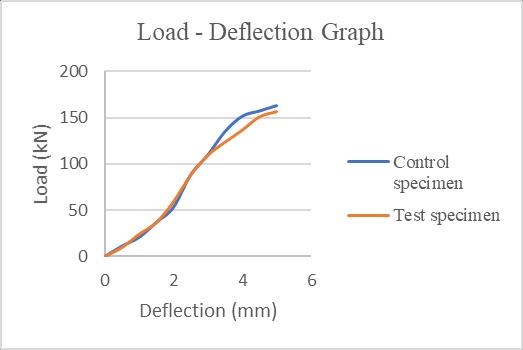International Research Journal of Engineering and Technology (IRJET) e-ISSN: 2395-0056
Volume: 09 Issue: 08 | Aug 2022 www.irjet.net p-ISSN: 2395-0072

International Research Journal of Engineering and Technology (IRJET) e-ISSN: 2395-0056
Volume: 09 Issue: 08 | Aug 2022 www.irjet.net p-ISSN: 2395-0072
2
1
Abstract - In recent decades, the application of selfcompacting concrete (SCC) has arise in construction structures because of its high qualities to improve durability and decrease bleeding with goodbonding with rebar. Besides, large amount of aggregates is required for the production of SCC. On the other hand, replacement of natural aggregate in SCC with waste materials can led to introduce ecological building materials. Walnut shell (WS)isoneofthenaturaland agriculture waste materials which can be used as a replacement for aggregate in SCC. In this research, WS was used as a substituent for coarse aggregate and flyash as mineral admixture for constructingSCCbyvolumefractionsof WS is 35%. The optimum percentage of flyash content is considered for the research. Fresh and hardened properties of SCC as well as lightweight self- compacting concrete (LWSCC) were investigated for the test mix and control one. The results showed that all tested properties have similar results of conventional SCC for flyash. However;theLWSCCcangetgood compressive strength for volume fraction of WS equalormore than 35%. Where, slump flow diameter (SFD), compressive strengths and split tensile strength for flyashwere560mm, 34 MPa and 3.22 MPa respectively achieved at 35% ratio of WS Flexural behaviour of reinforced concrete beam using this light weight aggregate is studied and compared with conventional SCC beam. Hence obtained similar results of conventional SCC.
Key Words: Self-compacting concrete, Walnut shell, Coarse aggregate, Mineral admixture, Lightweight selfcompacting concrete.
Concrete is a most viable engineering material used for construction Normal weight aggregates are such as limestone, granite and sandstone are common materials usedascoarseaggregatesinconcrete.Therearealsoother natural light weight aggregates such as: expanded shale, pumice,slate,perlite,bottomash,expandedclayetc.were successfullyusedintheproductionoflightweightconcretes (LWCs)overthedecades.Normalweightaggregatesareone ofthemajorconstituentsinconcrete,beitnormalconcrete or SCC. Aggregates are about 60% by volume in SCC and hence they are the main contributor to concrete weight.
About20billiontonsofmaterialswereusedforproduction ofconcreteannually.So,theestimatesofrawmaterialsfor the consumption of concrete will be in future is huge amount. Meanwhile, numerous contemporary research workshavededicatedtoreplacingnormalweightaggregates withlightweightaggregates(LWA).Generally,therearetwo classificationsofLightweightaggregate,whichareartificial typeandnaturaltype.Naturallysourcedaggregatesinclude pumice, diatomite, volcanic cinders, scoria and tuff while those in artificial category are classified into industrial by productsandmodifiednaturalarisingmaterials.Undeniably, morebenefitscanbederivedfromutilisingwastesmaterials to replace aggregates in concrete as it can reduce the environmental impacts with respect to waste reduction, pollutioncontainmentaswellaslessconsumptionofenergy. Givingathoughtonthisanattempthasbeenmadetoutilise naturalaggregatefortheconstruction.
The introduction of new materials, which act as structure massreductionandworkablematerialssuchaslightweight concrete (LWC) and self-compacting concrete (SCC) materials are one of the most recent technology in the modern construction industries. Lightweight selfcompactingconcrete(LWSCC)ispredictedtoproducehigh workabilitywhilenotsegregationandhighdurabilitywith reduced weight of SCC. Light- weight aggregate (LWA) is generally used in the LWC construction and can be manufacturedbynaturallysourcedorartificiallyconstructed fromprocessingby-productsofsomeindustrialprocesses. Lightweight concrete has a low viscosity and large rate of flow which is very important for concrete pumping, particularly in multi-storey buildings. The success to production of high quality LWSCC lies within the use and qualityofaggregates.
Walnutshell(WS)isoneofthenaturalandagriculturewaste materialswhichcanbeusedasasubstitutionofaggregatein SCC. The utilization of walnut shell aggregate with other quality additional cementing materials like fly ash can providehighlyworkableanddurableLWSCC.Useofthese aggregates provides property to the sustainable development by protective energy increasing structural propertiesandincreasingtheservicelifetimeofstructural lightweightconcrete(LWC). Compactionisnormallydone
2022, IRJET | Impact Factor value: 7.529 | ISO 9001:2008 Certified Journal | Page1784

International Research Journal of Engineering and Technology (IRJET) e-ISSN: 2395-0056

Volume: 09 Issue: 08 | Aug 2022 www.irjet.net p-ISSN: 2395-0072
with the help of vibrator during concreting and it raises concreting cost. In earnest quest for innovation in constructionindustryself-compactingconcrete(SCC)inlate 1980 s and is gradually gaining popularity. SCC have a propertiestoflowundergravityandmorecompactlyfillthe complex space of formwork as well as the area congested with reinforcement. LWSCC is capable of filling up the formworkandencapsulatereinforcementbyitsself-weight withouttheneedforextracompactionorexternalvibration. It has better segregation resistance, high flowability and passingabilityatfreshstateaswellasbettermechanicaland durabilitypropertiesinthehardenedstate.
Flyash is a fine powder that obtained as the byproduct of burning pulverized coal in electric generationpowerplants.Flyash isapozzolanicmaterial,a substancecontainingaluminousandsiliceousmaterialthat formscement inthepresenceofwater.Whenflyashmixed withlimeandwater,itformsacompoundsimilartoPortland cement. As perIS 3812: 2003, the generic name of the byproductduetoburningofcoalorligniteintheboilerofa thermal power plant is pulverized fuel ash. Fly ash is the pulverized fuel ash gets fromthe fuel gases by suitable processlikecycloneseparationor electrostaticprecipitation.
AccordingtoIS3812-1981,therearetwogradesofFlyash
1. Grade I fly ash,which are derived from bituminous coal having fractions SiO2+Al2O3+Fe2O3 greaterthan70%. 2. Grade II Fly ash, which are derived from lignitecoalhavingfractionsSiO2+Al2O3+Fe2O3 greaterthan50%
Table -1: ChemicalCompositionofFlyash[17]
Table -2: PhysicalPropertyofFlyash[17]
Sl.No. PhysicalProperty TestResults 1 Colour Grey 2 SpecificGravity 2.3
Use of Ordinary Portland Cement (OPC) of Grade 53 accordingtoISspecificationsismadeinthisinvestigation. Table3providescement'scharacteristics.
Table-3: PropertiesofOPC53GradeCement
Properties Test Results TechnicalReference
SpecificGravity 3.12 IS4031(PART11):1988 Consistency(%) 30 IS4031(PART4):1988 Finenessof Cement(%) 4.7 IS4031(PART2):1996 InitialSetting Time(minutes) 78 IS4031(PART5):1988
For building, manufactured sand (M-Sand) is an alternativetoriversand.M-sandisaproductmadefrom hard granite stone that has been crushed. M-Sand is less than4.75mminsize.Riversandisinshortsupply,hence artificial sand has been employed as an alternative for construction. M-Sand is also used since it is readily available and costs less to transport. Additionally, it is a dust-freematerialthatpollutesverylittle.Table4liststhe fineaggregate'scharacteristics.
Table-4:PropertiesofFineAggregate[25]
Properties TestResults
SpecificGravity 2.52 FinenessModulus 3.84 FreeSurfaceMoisture Nil
International Research Journal of Engineering and Technology (IRJET) e-ISSN: 2395-0056

Volume: 09 Issue: 08 | Aug 2022 www.irjet.net p-ISSN: 2395-0072
Aggregateswithaparticlesizerangeofmorethan4.75 mm, but typically between 10 and 40 mm in size. Concrete benefits from coarse aggregate's strength, toughness, and hardnessqualitiesaswellasitsresistancetoabrasion.The experimentalstudy'scoarseaggregatewas12.5mminsize and conformed to IS 383:1970. Table 5 lists the characteristicsofcoarseaggregate.
Table-5: PropertiesofCoarseAggregate
Properties TestResults TechnicalReference
Specific Gravity 2.69 IS2386(PART3):Clause 2.4.2
FreeSurface Moisture Nil IS383(PART3):1970 Fineness Modulus 4.25 IS383(PART 3): 1970 table2
Water is required to wet the surface of aggregate to developadhesivequalityasthecementpastebindsquickly andsatisfactorilytothewetsurfaceoftheaggregatesthan drysurface.Itiscommonlyacceptedviewthatanyportable water is suitable to be used in concrete making. It should haveinorganicsolidlessthan1000ppmandshouldbefree frominjuriousquantitiesofalkalies,acids,oils,salts,sugars, organicmaterials,vegetablegrowthorothersubstancethat maybedeleterioustobricks,stones,concreteorsteel.
AdmixturesaredefinedinACI116Ras“amaterialother than water, aggregates, hydraulic cement, and fiber reinforcement,usedasaningredientofconcreteormortar, and added to the batch right away before or during its mixing”. Chemical admixtures are used to upgrade the qualityofconcreteduringmixing,transporting,placement andcuring.
MASTERRHEOBUILD1126NDisanadmixtureofanew generation based on modifiednaphthalene formaldehyde ether. The product has been primarily developed for applicationsinhighperformanceconcretewherethehighest durabilityandperformanceisrequired.MASTERRHEOBUILD 1126NDisfreeofchloride&lowalkali.Itiscompatiblewith alltypesofcements.
MASTERRHEOBUILD 1126ND has a different chemical structurefromthetraditionalsuperplasticisers.Itconsistsof anaphthaleneformaldehydepolymerwithlongsidechains. Atthebeginningofthemixingprocess,itinitiatesthesame electrostaticdispersion mechanismasthetraditionalsuper
Factor value:
plasticisers, but the side chains linked to the polymer backbone generates a steric hindrance which greatly stabilizes the cement particles' ability to separate and disperse. Steric hindrance provides a physical barrier (alongside the electrostatic barrier) between the cement grains. With this process, flowable concrete with greatly reducedwatercontentisobtained.
Aspect DarkBrownLiquid
RelativeDensity 1.24±0.02at25 c pH ≥6
ChlorideIronContent ˂0.2%
2.6 Walnut Shell
Walnut shell has unique properties, it is very dense and takesyearsandyearstodecomposeorbreakdown.Itcanbe crushedandcouldbegroundintoseveralpiecesfromextra finetoextracourse.Duetotheexcessivehardnessofwalnut shell,walnutshellisusedasanabrasivethatisappliedto surfacepreparationoncementitioussurfacesincludingcastin-place concrete floors and walls, masonry walls, and shotcretesurfaces.Walnutshellisadequatelyhardnatural materialwhichcanbeusedascoarseaggregatepartiallyfor making lightweight concrete. However, its particle size, shapeandgradationwillaffectwork-abilityandstrengthof concrete.Moisturecontentandwaterabsorptionproperties willinfluenceshrinkageperformance.

Fig-1: WalnutShellandCrushed12.5mmWalnutShell

Table-7: PropertiesofWalnutShell[13]
SpecificGravity 0.96
WaterAbsorption 10% Thickness 0.86–1.35
SizeOfAggregate 12.5mm
International Research Journal of Engineering and Technology (IRJET) e-ISSN: 2395-0056

Volume: 09 Issue: 08 | Aug 2022 www.irjet.net p-ISSN: 2395-0072
Beamofsize150mmx200mmx1250mmwasusedfor the study.Atotalof2specimenwascasted.Thespecimen was tested by the optimum content of flyash 25% with optimum content of walnut shell 35% in self-compacting concrete. The beams were designed as balanced section, accordingtoIS456:2000andthedetails.
Therequiredquantitiesofcement,fineaggregate,coarse aggregate,superplasticisers,mineraladmixtureandwater weretakenforcontrolspecimens,inadditiontothis,walnut shell were mixed with the ingredients. Concrete was prepared by machine mixing. Initially cement and fine aggregateweremixedindrystateuntilitisofevencolour throughoutandfreefromstreaksfollowedbytheadditionof walnutshellandthenmeasuredquantityofcoarseaggregate wasspreadout.Thewholemasswasmixedbymachineinan angleof45%.Three quarter ofthetotal quantityofwater wasaddedwhilethematerialswereturnedintowardsthe centrewithspades.Theremainingwaterwasaddedslowly when the whole mixture was turning over and over again until a uniform colour and consistency was obtained throughout.
Themouldwasmadereadybyapplyingoilinallcontact surfaces.Thecontrolspecimensofnormalconcretecoverof 25mmwerepreparedbyplacingthereinforcementsinthe mouldwithsuitablecoverblocks.Concretewasspreadon themouldanduniformlyspreadthemixonthemould.The otherspecimenwascastbyaddingwalnutshellof35%to theconcrete.
Propersurfacefinishingwasprovided.Thespecimenwas removedfromthemouldafter24hoursandkeptforcuring. After28daysofcuring,specimenswerereadyfortesting.
Theexperimentalinvestigationofthisprojectincludessix (6)beams.Three(3)beamscastascontrolspecimenswithFe 415steelusingnormalM30mixandthree(3)beamscastas the 35 percentages of walnut shell as volume of coarse aggregateinconcrete.Allbeamshaveatotallengthof1250 mm, width of 150 mm and depth of 200 mm each. The longitudinalreinforcementwascalculatedusingIS456-2000 to obtain flexural failure and was same for all beams. The main lower reinforcement is 2#8 mm diameter and 8mm diameterstirrups.
The steel cover used was 25 mm. All beams were cast usingM30concretemix.Thebeamswerecuredusingjute bagswithroomtemperaturefor28days.Thecompressive strength of the concrete mix was measured after 28 days usingstandardcubes.Themeancompressivestrengthforthe mixwas35MPa.
Theflexuralstrengthofthespecimenswastestedusinga 30-ton loading frame. A dial gauge was attached at the bottomofthebeamtodeterminethedeflectionatthecentre ofthebeam.Fortestingofthespecimen,thesupportswere providedatadistanceof130mmfromtheedgesofthebeam. Theeffectivespanofthebeamwastakenas990mminthe case of 1250 mm beam. A proving ring of 500 kN was connected at the top of the beam to determine the load applied.
The flexural strength of the beam was tested as a twopointloadingsystemusingahydraulicjackof50tonattached to the loading frame. The behaviour of beam was keenly observed from beginning to the failure. The loading was stoppedwhenthebeamwasjustonthevergeofcollapse.The firstcrackpropagationanditsdevelopmentwereobserved carefully. The values of load applied and deflection were noteddirectlyandfurthertheplotofloadv/sdeflectionwas performed which was takenas the output. The load inKN wasappliedwithuniformlyincreasingthevalueoftheload and the deflection under the different applied loads was noted. The applied load was increased up to the breaking pointortillthefailureofthematerial.
Duetoincreaseintheload,thebeamstartstodeflect,upto certainleveltheloadv/sdeflectiongraphwillbelinearthat is load will be directly proportional to deflection. Due to further increase in the load, the load value will not be proportional to deflection, since the deflection values increasesasthestrengthofthematerialsgoesonincreasing materialloseselasticityandundergoesplasticdeformation. The deflection and the corresponding load, of RC beams reinforced with walnut shell as coarse aggregate were comparedwithnormalRCbeamsofSCC.
Theloadvaluesandcorrespondingdeflectionofcontrol specimensandotherspecimensaregivenintable8.Flexural cracksandshearcrackswereformedinthemid-spanand quarterspanrespectivelyofallthetestedbeams.Noshear failure of the beam was observed till the failure. The maximumloadvaluesand maximumvertical deflectionat midspanisgivenintable8andobservedthatthemaximum load was carried by the RC beams walnut shell as coarse aggregate.
Figure 2 indicates the load-deflection curves of control beamsandRCbeamsreinforcedwithwalnutshellascoarse aggregate.ThetestresultsclearlyindicatedthatRCbeams reinforcedwithwalnutshellascoarseaggregatehassimilar loadcomparedwiththecontrolbeams.
International Research Journal of Engineering and Technology (IRJET) e-ISSN: 2395-0056

Volume: 09 Issue: 08 | Aug 2022 www.irjet.net p-ISSN: 2395-0072
Table-8 Load–Deflection
Deflection (mm)
Control specimenLoad (kN) TestspecimenLoad (kN) 0 0 0 0.5 11.26 9.806 1 20.71 24.065
1.5 36.77 36.77 2 53.0333 59.226 2.5 88.0332 88.0332 3 109.484 109.485 3.5 134.74 123.839 4 151.194 136.74 4.5 156.88 151.194 5 162.646 156.88
The beam casted using the same mixture carried andfoundbothcontrolbeamandtestbeamshows similarbehaviour
The beam failures flexurally and cracks were formedwithaninclination
Chart-1: Load-DeflectionGraph

ThemainaimwastostudythepropertiesofLWCusing walnutshellascoarseaggregatewiththeconventionalselfcompacting concrete. From the studies we come to the followingconclusions:
FromthestudyitshowsthatLWCrequireddensity below2000kg/m³andwiththerequiredstrength were 38 MPa and we obtained density as per the studyandstrengthobtainedwas34MPa.
Fromtheobtainedresults35%givestheeffective replacementofcoarseaggregatewithwalnutshell givessimilarstrengthofself-compactingconcrete
Initially number of cracks formed are few in numberandalso,theyarehairlinecracks
Crackswereformedinthetensionzoneofthebeam
1. AnandDevB.G.andJayasreeS.(2017),“Effectof LightweightAggregateontheFlexuralBehaviourof SelfCompactingConcrete”, International Journal of Scientific and Engineering Research,Vol.7,Issue10, pp: 16 – 22
2. Arul sivanantham P. and Gokul R. (2018), “A ReviewonSelfCompactingConcrete”, International Journal of Chem Research,Vol.10,Issue11,pp: 62 –68
3. DominicStefanLawYimWan,FarhadAslaniand Guowei Ma (2018), “Lightweight Self-Compacting Concrete Incorporating Perlite, Scoria, and PolystyreneAggregates”, Journal of material in civil engineering, Vol. 8, Issue 30, pp: 1 –13
4. E. Guneyisi et. al, (2013), “Performance of Self Compacting Concrete (SCC) with High Volume Supplementary Cementitious Material (SCMs)”, Science Direct,pp:198–217
5. Idowu H. Adebakin, K. Gunasekaran and R. Annadurai (2018), “Mix Design and Rheological Properties of Self-Compacting Coconut Shell Aggregate Concrete”, Journal of Engineering and Applied Science,pp:465–1475
6. JingjunLi,EnjiaZhao,JiangangNiuandChaojun Wan,(2020),“Studyonmixturedesignmethodand mechanicalpropertiesofsteelfiberreinforcedselfcompactinglightweightaggregateconcrete”, Science Direct,pp:1–15
7. K. J. H. Zhou and Ho and Su (2011), “Flexural Strength and Deformability Design of Reinforced Concrete Beams”, Science Direct,Vol.14,pp:1399–1407
8. K.S. Elango, D. Vivek, S. Anandaraj, R. Saravanakumar, J. Sanfeer and S. Saravanaganesh (2021), “Experimental study on self-compacting concrete using light weight aggregate”, Science Direct,Vol.14,pp:1–6
International Research Journal of Engineering and Technology (IRJET) e-ISSN: 2395-0056 Volume: 09 Issue: 08 | Aug 2022 www.irjet.net p-ISSN: 2395-0072
9. Mahmoud Khashaa Mohammed, Abdulkader IsmailAl-HadithiandMarwaH.Mohammed(2019), “Productionandoptimizationofeco-efficientselfcompactingconcreteSCCwithlimestoneandPET”, Science Direct,Vol.197,pp:734-746
10. Mohammed Sonebi and AmmarYahia (2020), “Mix Design Procedure, Tests and Standards”, Science Direct,pp:1-30
11. MojdehMehrinejadKhotbehsara,EhsanMohseni, TogayOzbakkalogluandMalekMohammadRanjbar (2017), “Durability Characteristics of SelfCompacting Concrete Incorporating Pumice and Metakaolin”, Journal of Materials in Civil Engineering,Vol. 11, Issue 29,pp:1-9
12. Mouhcine Ben Aicha (2020), “The Superplasticizer Effect on The Rheological and MechanicalPropertiesofSelfCompactingConcrete”, Science Direct,pp:315–331
13. Nahla Hilal, Taghreed Kh Mohammed Ali and Bassam A. Tayeh (2021), “Fresh and Hardened PropertiesofLightweightSelf-CompactingConcrete Containing Walnut Shells as Coarse Aggregate”, Science Direct,Vol.33,pp:364–372
14. Nahla Hilal, Taghreed Kh Mohammed Ali and Bassam A. Tayeh (2020), “Properties of environmental concrete that contains crushed walnutshellaspartialreplacementforaggregates”, Arabian Journal of Geosciences,pp:1–9
15. Paratibha Aggarwal (2008), “Self-Compacting Concrete – Procedure for Mix Design”, Leonardo Electronic Journal of Practices and Technologies”, Vol.12,pp:15–24
16. ParatibhaAggarwal,KiranDeviandBabitaSaini (2019), “Admixtures Used inSelf-Compacting Concrete:AReview”, Iranian Journal of Science and Technology, Transactions of Civil Engineering”,Vol. 8,Issue 30,pp:15–42
17. Peter A. Classie (2016), “Admixtures for Concrete” Science Direct,pp251–258
18. R.GopiandV.Revathi(2020),“Flexuralbehavior of self-compacting self-curing concrete with lightweightaggregates”, Science Direct”,Vol.12,pp: 1–7
19. Timothy Zhi Hong Ting, Muhammad Ekhlasur Rahman and Hieng Ho Lau (2020), “Sustainable lightweightself-compactingconcreteusingoilpalm shellandflyash”, Science Direct,Vol.12,pp:1–13
20. Weimin Cheng, Guoming Liu and Lianjun Chen (2017), “Pet Fiber Reinforced Wet-Mix Shotcrete withWalnutShellasReplacedAggregate”, Applied Science,Vol.7,Issue345pp:1–19
21. IS10262:2009[mixdesign]22.IS456-2000
22. IS4031-1988[Standardconsistencyofcement]
23. IS2720(PartIII)[Specificgravityofcement]
24. IS12269-1987 [Finenessofcement]
25. IS2386(Part-III)-1963[Fineaggregates]
26. IS383:1970[sieveanalysis]
27. IS2386(Part-III)-1970[coarseaggregate]
28. EFNARC-Specifications and Guidelines for SelfCompactingConcrete
2022, IRJET | Impact Factor value: 7.529 | ISO 9001:2008 Certified Journal |
